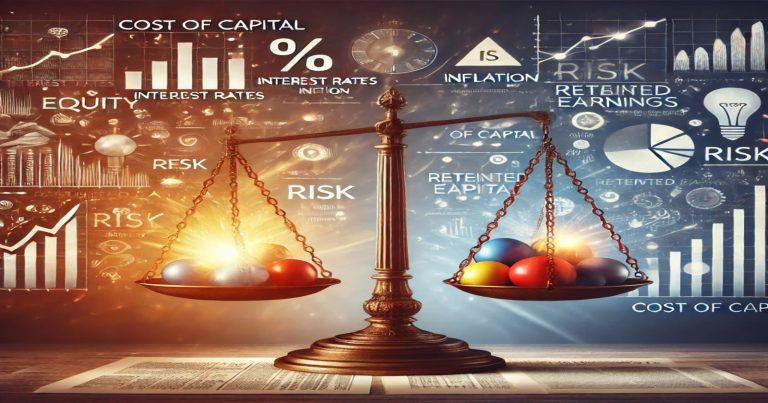Competition and survival are the underlying objectives of all business activities that have diverse economic capacities. Such sources of capital are usually those represented by leveraging, equity, and profiteering. A unit in this situation is the price of capital associated with one dollar of debt. The cost of capital can be sourced from anywhere at different rates, according to a variety of both internal and external factors. Internal factors include customer financial decisions, operational efficiency, and funding risk. External factors are economic conditions, market conditions, and interest rates. Companies with a low cost of capital are able to invest more in expansion, whereas companies with a high cost of capital are unable to expand.
What is Cost of Capital?
Cost of capital is the amount a firm pays to acquire funds for operating the business and making investments. It is a numeral and represents the rate of return that investors want before they will invest, or to what in a way be lenders earn. Companies collect capital from a variety of places, such as:
- Debt – Bank loans or bonds sold to investors. The cost of debt is the interest on the loans.
- Equity – Shareholders’ funds that are invested in the company. Cost of equity is the expected return from shareholders.
- Retained Earnings – Income that the business retains for investment rather than paying out as dividends.
The total cost of capital is a combination of the costs of these sources. Companies attempt to balance debt and equity to keep the cost of capital minimal. A high cost of capital can decrease profits, whereas a low cost of capital enables companies to grow effectively.
Factors Affecting Cost of Capital
The different sources define the elements that affect the cost of capital in more detail. Some elements might be controlled by the company, but others are beyond the reach of a company with reference to the economy and capital markets. The significant factors are:
1. General Economic Conditions
2. Market Conditions
3. Operating and Financing Decisions
4. Amount of Financing
General Economic Conditions
Economy’s condition is the major factor behind the ease of funds availability for the businesses. Companies have no influence over the economic situation, however, they can develop a plan to adapt to those changes. The market environment is strong enough to cause a company to be very successful, despite other issues (such as government policy). But, they may also be the downfall of the firm. The value of an item that may or may not be controlled by a company is the factor which leads to the success or failure of a company in relation to theirs. The adaptation of strategies is of great importance to sail through the changes of tides.
Inflation and Interest Rates
With a decrease in the purchasing power of the banknote, the creditors are to claim a higher interest on loans to cover the depreciation of money value brought by inflating the period of time. The towering costs of living which inflation brings about exert pressure on monetary values held. Coping prudently with the rising prices and evolving rates of interest is prudent for all enterprises seeking to utilize credit for development. When inflation balloons from 4% to 8%, banks elevate loan interest from 7% to a steeper 11%, pricing many organizations out of being able to afford borrowing. The rise or fall of inflation impacts interest rates and accessibility to capital, a balancing act enterprises must navigate carefully.
Government Policies
When the government changes taxes, monetary rules, or foreign investment policies, it affects how much companies have to pay to borrow money. For instance, if business taxes are reduced, companies can keep more of their profits. As a result, they might not need to borrow as much money from other sources.
Economic Growth
When there is economic growth, businesses make more profits and have access to capital with less difficulty. But in recession, investors ask for more returns because of risk, which makes the cost of capital higher.
Market Conditions
Market conditions affect the supply and price of funds. These involve trends in the stock market, investment demand, and investor confidence.
Stock Market Performance
If stock markets are doing well, companies can raise equity capital smoothly. More investors are interested in purchasing shares, which means the cost of equity decreases. But in a bear market, companies have to pay more returns to get the investors.
Credit Market Conditions
When credit is cheap, the borrowing costs will also be low. An abundance of money in the hands of lenders means that they will have to compete and offer loans with better terms, thus reducing borrowing costs. Credit is generally hard to come by during times of turbulence, as this is the time when more people want to access loans, and hence costs will increase. However, a few companies that have provided different avenues to attract investors by offering different classes of assets have displayed great ingenuity.
Risk Perception
Investors measure the amount of risk prior to investing. If a firm is risky, investors want a higher return, and this increases the cost of capital. Stable profit firms that are safe can acquire funds at lower costs.
Operating and Financing Decisions
A firm’s internal decisions have significant effects on how much money it needs from external sources.
Debt-Equity Ratio
If it accurately picks its own debt/equity ratio–the best possible capital mix for the business–then a firm can enjoy lower costs of capital. If a business is too dependent on debt for financial resolve, creditors will view this as an increased risk factor. Hence, they impose higher interest rates and fees upon borrowing money from them. On the other hand, too heavy an investment in shareholders’ funds will hike expectations of stockholders for dividends with future implications that are expensive and difficult to live up to.
Profitability and Growth Potential
The most interesting companies with growing room not will appeal to the investor or lender–if it promises growth its customers can bring out are also most attractive places to put your money.Thus if the company could repay its debts on time and with speed, shareholders were happy: after all they could see lots more in the way of cash or other kinds of less than 10% cost of capital also means that for a company rated AA by an investment bank, there would be very little in the way of financial charges.
Risk Management
Well-managed companies can raise funds at lower expenses. Companies with stable businesses, good cash flows, and a record of prompt repayments are offered better loan terms.
Amount of Financing
The amount of funds a company needs also affects the cost of capital.
Size of the Capital Requirement
Big firms with big funding requirements typically enjoy better terms on loans since they have a proven track record of finances. Small firms with smaller capital requirements might have to pay more since they lack access to cheap capital.
Source of Funds
Firms that raise capital through borrowing may receive lower interest rates compared to those using equity financing. But excessive borrowing raises financial risk, and future borrowing becomes costly.
Maturity of Debt
Short-term loans generally come with lower interest rates than long-term loans. But, because you might need to borrow short-term loans more often, the overall cost can end up being higher in the long run.
Relevance to ACCA Syllabus
Why is it so important for ACCA candidates? Financing decisions, capital structure, and risk assessment are topics explored in FM and AFM. There are tons of tips that can be found on the internet, as mastering this concept is an integral part for ACCA students assessing business funding options and maximising financial performance.
Factors Affecting Cost of Capital ACCA Questions
- Which factor is most likely to increase the cost of debt for a company?
A) A low rate of inflation - B) A good credit standing
- C) Rising interest rates in the market.
- D) A drop in government bonds’ return rates
- Ans: C) Rising interest rates in the market
2. Which of the following is considered to be an important factor in calculations of the cost of capital?
A) Market rates of interest
B) Stock market movements
C) Debt-equity ratio
D) Inflation
Ans: C) debt-equity ratio
3. A company perceived as a high-risk premium will experience
A) Lower cost of equity
B) Investors demanding a higher return
C) Interest rates fall on debt
D) A capital supply gap that is cheap in which cheap capital becomes available to investors.
4. People rated by Which of the following policies are that able to give a company a direct reduction in their cost of capital?
A) Increasing the proportion of profit ceded
B) To improve your credit standing while taking less default risk
C) More equity
D) Cancel short-term commercial loans for expenses
Ans: B) to improve your credit standing while taking less default risk
Relevance to US CMA Syllabus
US CMA curriculum covers cost of capital under Financial Decision Making. CMA candidates should know how business financing decisions, economic conditions, and market risks influence the cost of capital to make investment and funding strategic decisions.
Factors Affecting Cost of Capital US CMA Questions
- Which of the following statements is true regarding a firm’s cost of capital?
A) The cost of capital remains constant regardless of financial leverage
B) Debt financing is always more expensive than equity financing
C) A higher credit rating usually lowers the cost of capital
D) The cost of retained earnings is always zero
Ans: C) A higher credit rating usually lowers the cost of capital - Which factor has the most significant impact on the weighted average cost of capital (WACC)?
A) The company’s total revenue
B) Changes in corporate tax rates
C) The company’s advertising expenses
D) The CEO’s salary
Ans: B) Changes in corporate tax rates - If the Federal Reserve raises interest rates, what impact does it have on a company’s cost of debt?
A) No effect
B) Decreases the cost of debt
C) Increases the cost of debt
D) Reduces the risk premium
Ans: C) Increases the cost of debt - A company looking to reduce its WACC should consider which of the following strategies?
A) Increasing high-interest short-term loans
B) Shifting to a more debt-heavy capital structure when interest rates are low
C) Issuing more common stock to fund operations
D) Paying out higher dividends
Ans: B) Shifting to a more debt-heavy capital structure when interest rates are low
Relevance to CFA Syllabus
CFA syllabus includes cost of capital under Financial Decision Making. CFA aspirants must be aware of how economic conditions, market risks, and business financing choices affect the cost of capital, enabling them to make strategic investment and funding decisions.
Factors Affecting Cost of Capital CFA Questions
- Which of the following best describes the relationship between risk and the cost of capital?
A) As risk increases, cost of capital decreases
B) Risk and cost of capital are unrelated
C) Higher risk requires a higher return, increasing the cost of capital
D) Higher risk reduces the cost of capital by attracting more investors
Ans: C) Higher risk requires a higher return, increasing the cost of capital - A firm with a beta greater than 1 will likely experience which of the following?
A) A lower cost of equity
B) The same cost of capital as the market
C) Higher cost of capital due to higher systematic risk
D) No impact on its WACC
Ans: C) Higher cost of capital due to higher systematic risk - Which of the following factors would likely reduce a company’s cost of capital?
A) An increase in market interest rates
B) A decrease in corporate tax rates
C) An increase in the company’s default risk
D) A reduction in credit ratings
Ans: B) A decrease in corporate tax rates - Which of the following financing decisions would increase a company’s cost of capital?
A) Issuing more equity to reduce debt
B) Maintaining a strong credit rating
C) Relying heavily on high-interest debt
D) Reducing dividend payments
Ans: C) Relying heavily on high-interest debt
Relevance to US CPA Syllabus
The US CPA examination includes cost of capital in the Financial Accounting and Reporting (FAR) and Business Environment and Concepts (BEC) topics. CPA aspirants need to know how financial decisions and economic conditions influence financial reporting and capital structure.
Factors Affecting Cost of Capital US CPA Questions
- What happens to a firm’s WACC if the proportion of debt increases, assuming tax benefits remain constant?
A) WACC increases because debt is more expensive than equity
B) WACC remains the same since capital structure does not affect it
C) WACC decreases since debt is usually cheaper due to tax deductibility
D) WACC decreases because shareholders require lower returns
Ans: C) WACC decreases since debt is usually cheaper due to tax deductibility - Which of the following external factors has the most significant impact on cost of capital?
A) Marketing strategies
B) Economic conditions and interest rates
C) Employee salaries
D) Inventory turnover rates
Ans: B) Economic conditions and interest rates - How does an increase in corporate income tax affect the after-tax cost of debt?
A) Increases it because lenders demand higher interest rates
B) Decreases it due to the tax shield on interest payments
C) Has no impact on cost of debt
D) Eliminates the need for debt financing
Ans: B) Decreases it due to the tax shield on interest payments
Which of the following capital structure changes would lead to an increase in the company’s WACC?
A) Issuing more long-term debt at low interest rates
B) Reducing equity financing and increasing retained earnings
C) Raising high-risk, high-cost debt financing
D) Improving the company’s bond rating
Ans: C) Raising high-risk, high-cost debt financing


